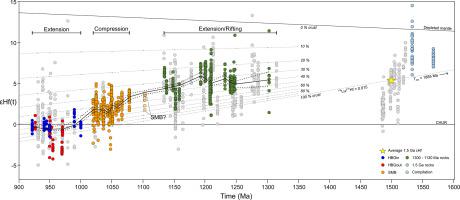当前位置:
X-MOL 学术
›
Gondwana Res.
›
论文详情
Our official English website, www.x-mol.net, welcomes your
feedback! (Note: you will need to create a separate account there.)
Multi-isotope tracing of the 1.3–0.9 Ga evolution of Fennoscandia; crustal growth during the Sveconorwegian orogeny
Gondwana Research ( IF 7.2 ) Pub Date : 2021-03-01 , DOI: 10.1016/j.gr.2020.10.019 Anette Granseth , Trond Slagstad , Nick M.W. Roberts , Graham Hagen-Peter , Christopher L. Kirkland , Steinar H.H. Møkkelgjerd , Torkil S. Røhr , Nolwenn Coint , Bjørn Eske Sørensen
Gondwana Research ( IF 7.2 ) Pub Date : 2021-03-01 , DOI: 10.1016/j.gr.2020.10.019 Anette Granseth , Trond Slagstad , Nick M.W. Roberts , Graham Hagen-Peter , Christopher L. Kirkland , Steinar H.H. Møkkelgjerd , Torkil S. Røhr , Nolwenn Coint , Bjørn Eske Sørensen

|
Abstract Magmatism between 1.3 and 0.9 Ga at the southwestern margin of Fennoscandia, comprising mainly granitic batholiths and subordinate bimodal volcanic rocks, provides a nearly continuous magmatic record of the Fennoscandian tectonic evolution. Here, we present new and published zircon Hf, K-feldspar Pb and whole-rock Sr isotopic data from the granitic rocks. The eHf isotopic evolution since 1300 Ma starts out as relatively juvenile, with a flat superchondritic trend at 1300–1130 Ma followed by a steeper trend towards lower, but still superchondritic values at 1070–1010 Ma. During the 1000–920 Ma period, the trend flattens out at near-chondritic values. The variations between flat and steep eHf trends correspond to previously documented extensional and compressional periods, respectively. Although the change to a steeper eHf trend at ca. 1100 Ma may indicate the emergence of a new isotopic reservoir (i.e. a colliding continent), there is no corresponding change in the K-feldspar Pb or whole-rock Sr isotopic composition. We argue that the trends are better explained by varying proportions of isotopically evolved crust and juvenile mantle in the magma source regions, similar to Nd and Hf isotopic pull-downs and pull-ups observed in many accretionary orogenic systems. We therefore conclude that continuous accretionary processes without involvement of exotic sources is the best explanation for the isotopic evolution before and during the Sveconorwegian orogeny, and that the orogeny involved generation of significant volumes of new crust to the SW margin of the Fennoscandia.
中文翻译:

Fennoscandia 1.3-0.9 Ga 演化的多同位素示踪;Sveconorwegian造山运动期间的地壳生长
摘要 Fennoscandia 西南缘1.3-0.9 Ga 岩浆活动,主要由花岗岩基岩和次要的双峰火山岩组成,为Fennoscandian 构造演化提供了近乎连续的岩浆记录。在这里,我们展示了来自花岗岩的新的和已发表的锆石 Hf、钾长石 Pb 和全岩 Sr 同位素数据。自 1300 Ma 以来的 eHf 同位素演化开始时相对较年轻,在 1300-1130 Ma 处具有平坦的超球粒陨石趋势,然后在 1070-1010 Ma 处趋于更低但仍然是超球粒陨石值的陡峭趋势。在 1000-920 Ma 期间,趋势在接近球粒陨石值时趋于平缓。平坦和陡峭 eHf 趋势之间的变化分别对应于先前记录的拉伸和压缩周期。尽管在约 2 小时变为更陡峭的 eHf 趋势。1100 Ma可能预示着新的同位素储层(即碰撞大陆)的出现,钾长石Pb或全岩Sr同位素组成没有相应的变化。我们认为,这些趋势可以通过岩浆源区同位素演化地壳和新生地幔的不同比例来更好地解释,类似于在许多增生造山系统中观察到的 Nd 和 Hf 同位素下拉和上拉。因此,我们得出结论,没有外来源参与的连续增生过程是斯韦科诺韦造山运动之前和期间同位素演化的最佳解释,并且造山运动涉及到芬诺斯坎迪亚西南边缘产生大量新地壳。钾长石 Pb 或全岩 Sr 同位素组成没有相应的变化。我们认为,这些趋势可以通过岩浆源区同位素演化地壳和新生地幔的不同比例来更好地解释,类似于在许多增生造山系统中观察到的 Nd 和 Hf 同位素下拉和上拉。因此,我们得出结论,没有外来源参与的连续增生过程是斯韦科诺韦造山运动之前和期间同位素演化的最佳解释,并且造山运动涉及到芬诺斯坎迪亚西南边缘产生大量新地壳。钾长石 Pb 或全岩 Sr 同位素组成没有相应的变化。我们认为,这些趋势可以通过岩浆源区同位素演化地壳和新生地幔的不同比例来更好地解释,类似于在许多增生造山系统中观察到的 Nd 和 Hf 同位素下拉和上拉。因此,我们得出结论,没有外来源参与的连续增生过程是斯韦科诺韦造山运动之前和期间同位素演化的最佳解释,并且造山运动涉及到芬诺斯坎迪亚西南边缘产生大量新地壳。我们认为,这些趋势可以通过岩浆源区同位素演化地壳和新生地幔的不同比例来更好地解释,类似于在许多增生造山系统中观察到的 Nd 和 Hf 同位素下拉和上拉。因此,我们得出结论,没有外来源参与的连续增生过程是斯韦科诺韦造山运动之前和期间同位素演化的最佳解释,并且造山运动涉及到芬诺斯坎迪亚西南边缘产生大量新地壳。我们认为,这些趋势可以通过岩浆源区同位素演化地壳和新生地幔的不同比例来更好地解释,类似于在许多增生造山系统中观察到的 Nd 和 Hf 同位素下拉和上拉。因此,我们得出结论,没有外来源参与的连续增生过程是斯韦科诺韦造山运动之前和期间同位素演化的最佳解释,并且造山运动涉及到芬诺斯坎迪亚西南边缘产生大量新地壳。
更新日期:2021-03-01
中文翻译:

Fennoscandia 1.3-0.9 Ga 演化的多同位素示踪;Sveconorwegian造山运动期间的地壳生长
摘要 Fennoscandia 西南缘1.3-0.9 Ga 岩浆活动,主要由花岗岩基岩和次要的双峰火山岩组成,为Fennoscandian 构造演化提供了近乎连续的岩浆记录。在这里,我们展示了来自花岗岩的新的和已发表的锆石 Hf、钾长石 Pb 和全岩 Sr 同位素数据。自 1300 Ma 以来的 eHf 同位素演化开始时相对较年轻,在 1300-1130 Ma 处具有平坦的超球粒陨石趋势,然后在 1070-1010 Ma 处趋于更低但仍然是超球粒陨石值的陡峭趋势。在 1000-920 Ma 期间,趋势在接近球粒陨石值时趋于平缓。平坦和陡峭 eHf 趋势之间的变化分别对应于先前记录的拉伸和压缩周期。尽管在约 2 小时变为更陡峭的 eHf 趋势。1100 Ma可能预示着新的同位素储层(即碰撞大陆)的出现,钾长石Pb或全岩Sr同位素组成没有相应的变化。我们认为,这些趋势可以通过岩浆源区同位素演化地壳和新生地幔的不同比例来更好地解释,类似于在许多增生造山系统中观察到的 Nd 和 Hf 同位素下拉和上拉。因此,我们得出结论,没有外来源参与的连续增生过程是斯韦科诺韦造山运动之前和期间同位素演化的最佳解释,并且造山运动涉及到芬诺斯坎迪亚西南边缘产生大量新地壳。钾长石 Pb 或全岩 Sr 同位素组成没有相应的变化。我们认为,这些趋势可以通过岩浆源区同位素演化地壳和新生地幔的不同比例来更好地解释,类似于在许多增生造山系统中观察到的 Nd 和 Hf 同位素下拉和上拉。因此,我们得出结论,没有外来源参与的连续增生过程是斯韦科诺韦造山运动之前和期间同位素演化的最佳解释,并且造山运动涉及到芬诺斯坎迪亚西南边缘产生大量新地壳。钾长石 Pb 或全岩 Sr 同位素组成没有相应的变化。我们认为,这些趋势可以通过岩浆源区同位素演化地壳和新生地幔的不同比例来更好地解释,类似于在许多增生造山系统中观察到的 Nd 和 Hf 同位素下拉和上拉。因此,我们得出结论,没有外来源参与的连续增生过程是斯韦科诺韦造山运动之前和期间同位素演化的最佳解释,并且造山运动涉及到芬诺斯坎迪亚西南边缘产生大量新地壳。我们认为,这些趋势可以通过岩浆源区同位素演化地壳和新生地幔的不同比例来更好地解释,类似于在许多增生造山系统中观察到的 Nd 和 Hf 同位素下拉和上拉。因此,我们得出结论,没有外来源参与的连续增生过程是斯韦科诺韦造山运动之前和期间同位素演化的最佳解释,并且造山运动涉及到芬诺斯坎迪亚西南边缘产生大量新地壳。我们认为,这些趋势可以通过岩浆源区同位素演化地壳和新生地幔的不同比例来更好地解释,类似于在许多增生造山系统中观察到的 Nd 和 Hf 同位素下拉和上拉。因此,我们得出结论,没有外来源参与的连续增生过程是斯韦科诺韦造山运动之前和期间同位素演化的最佳解释,并且造山运动涉及到芬诺斯坎迪亚西南边缘产生大量新地壳。











































 京公网安备 11010802027423号
京公网安备 11010802027423号